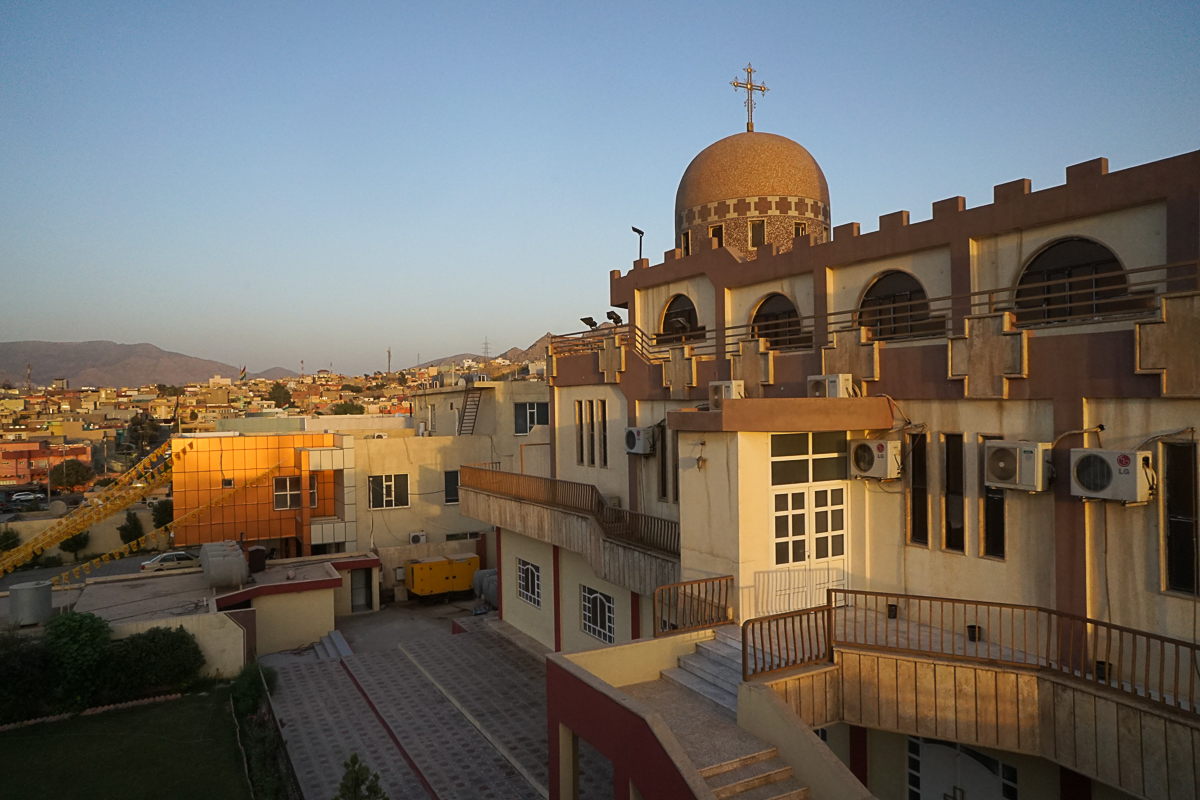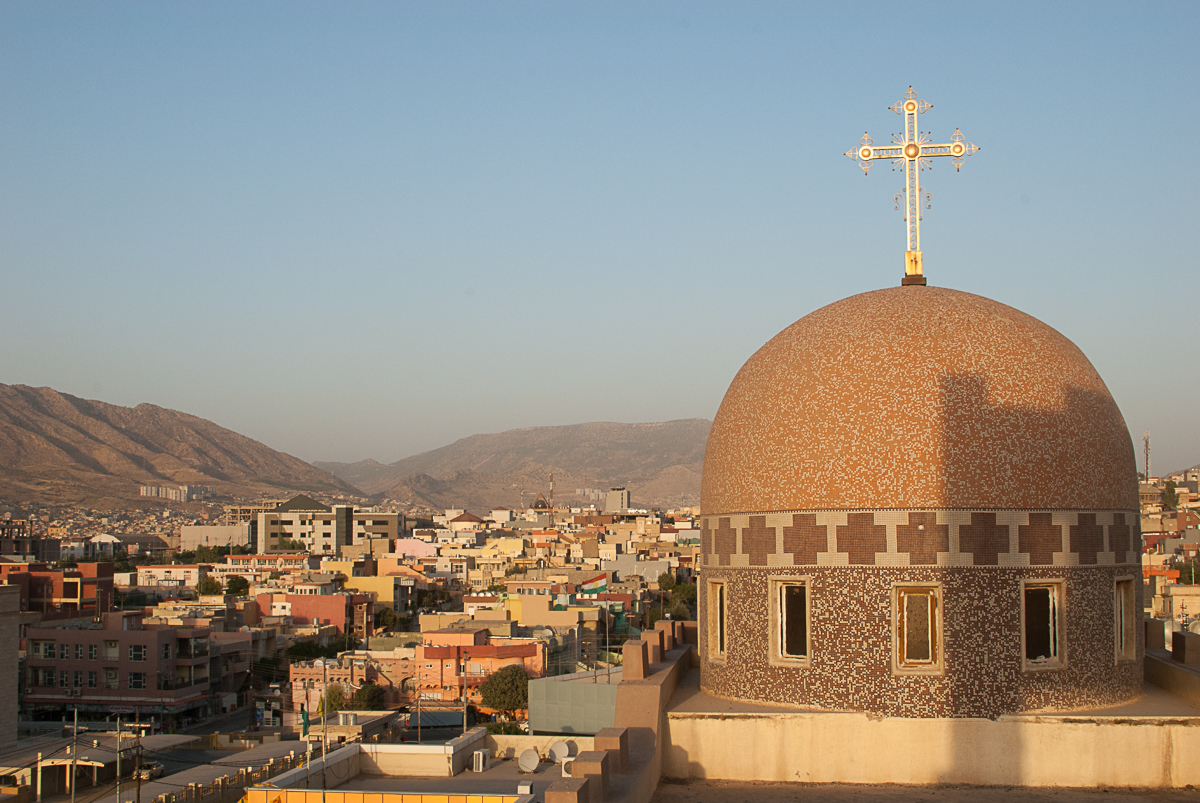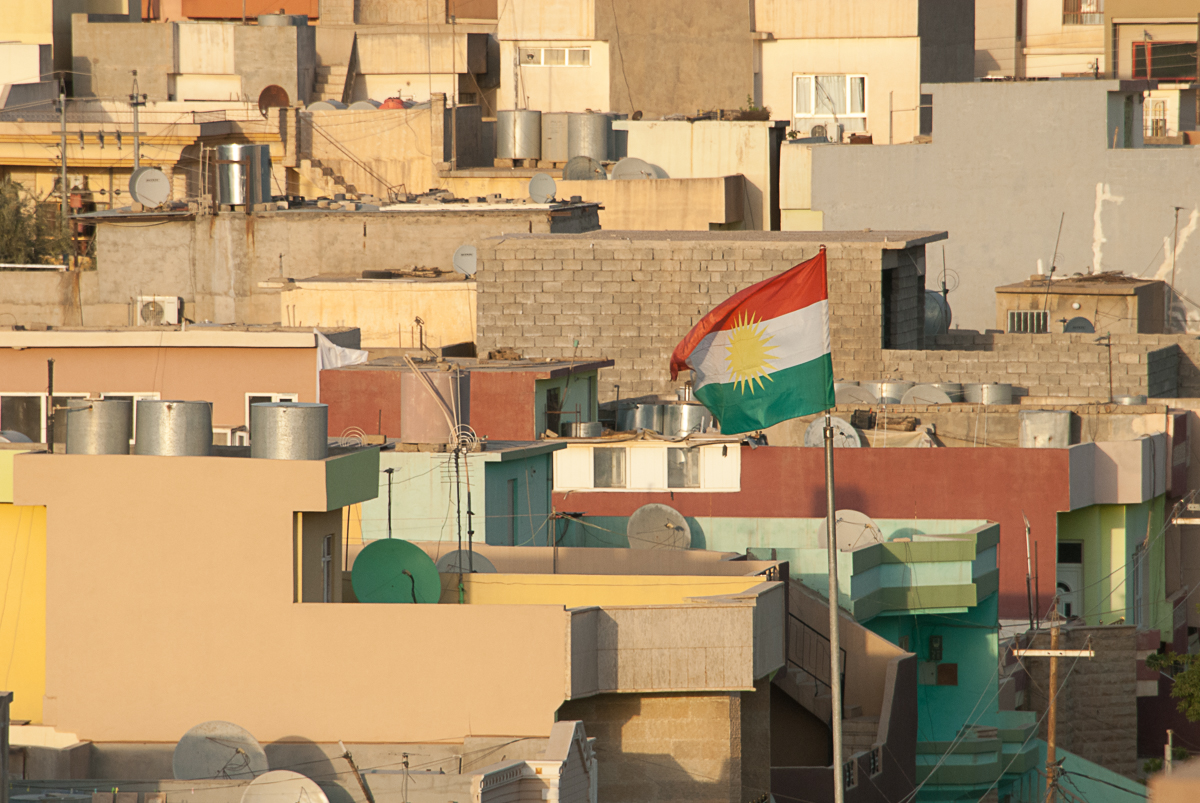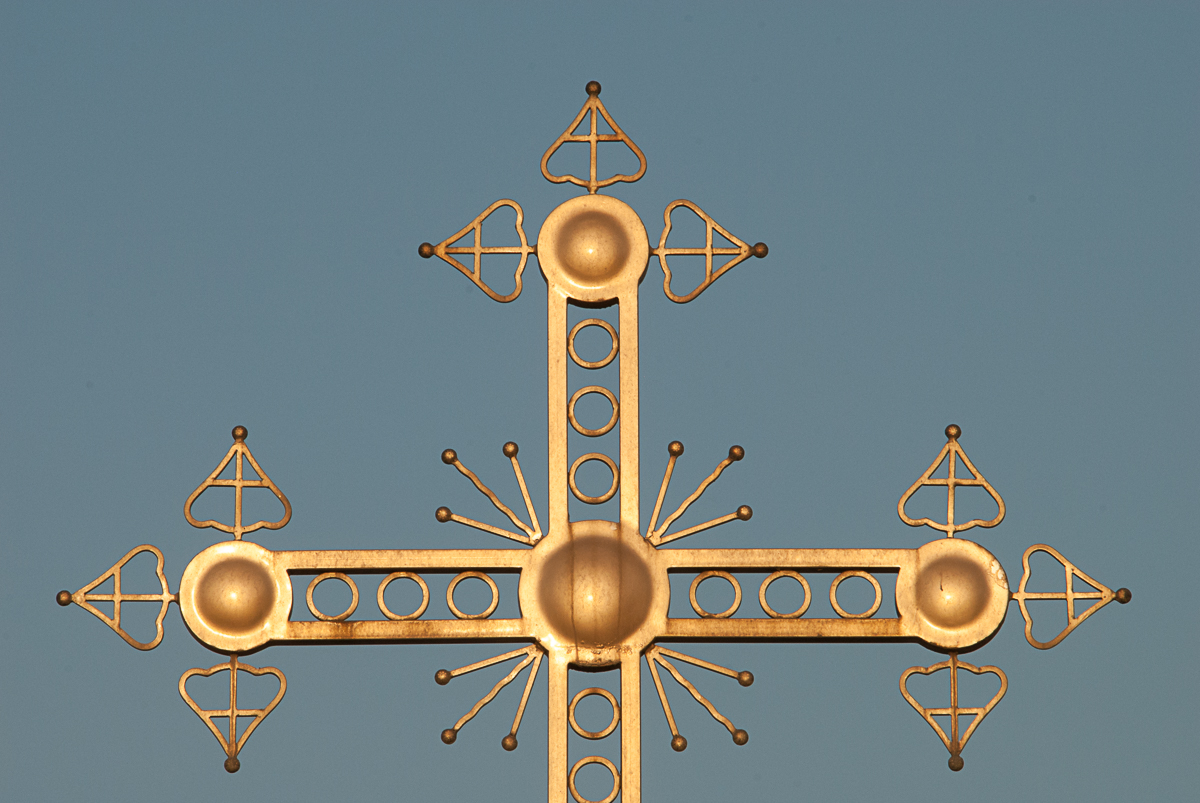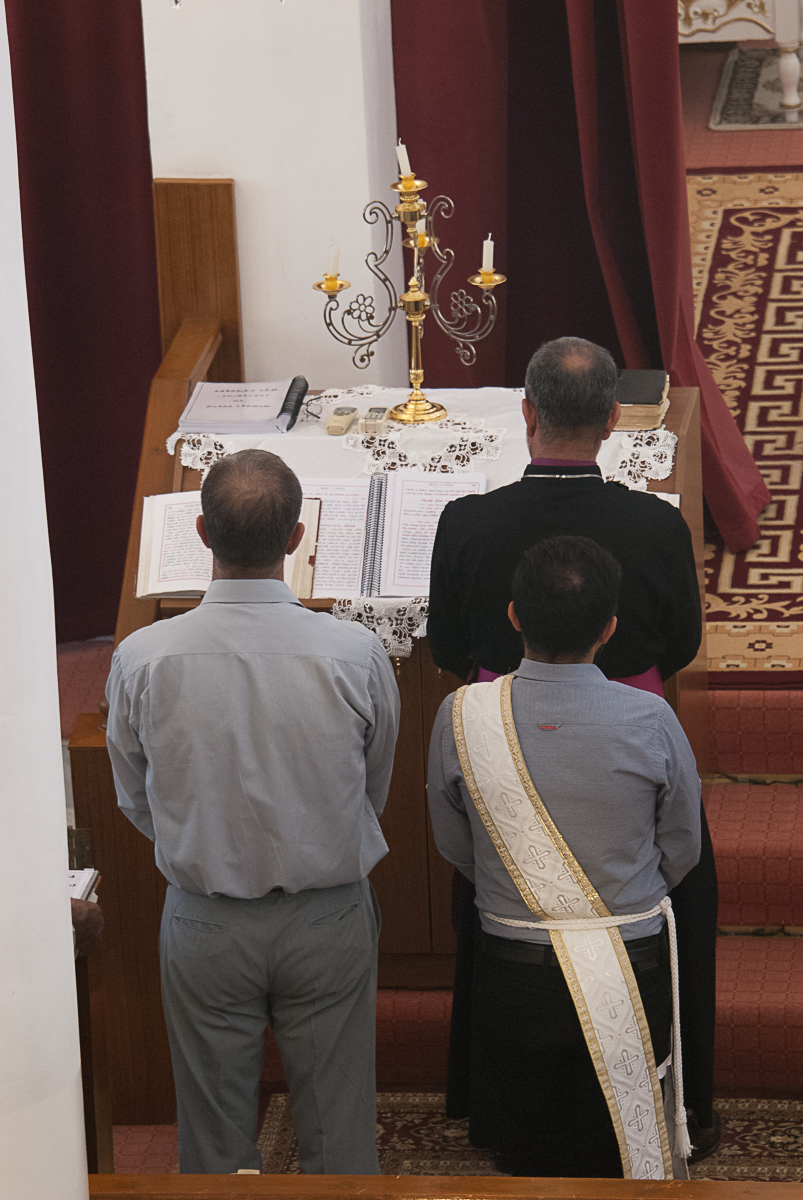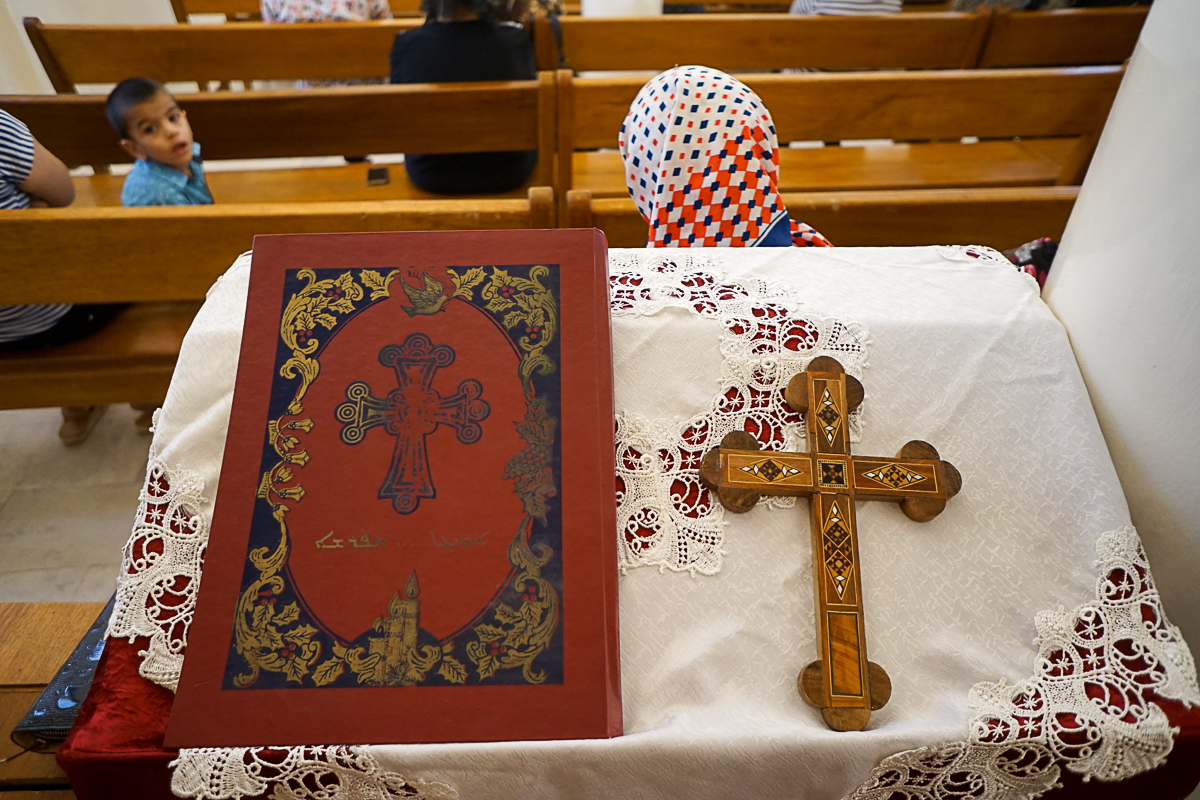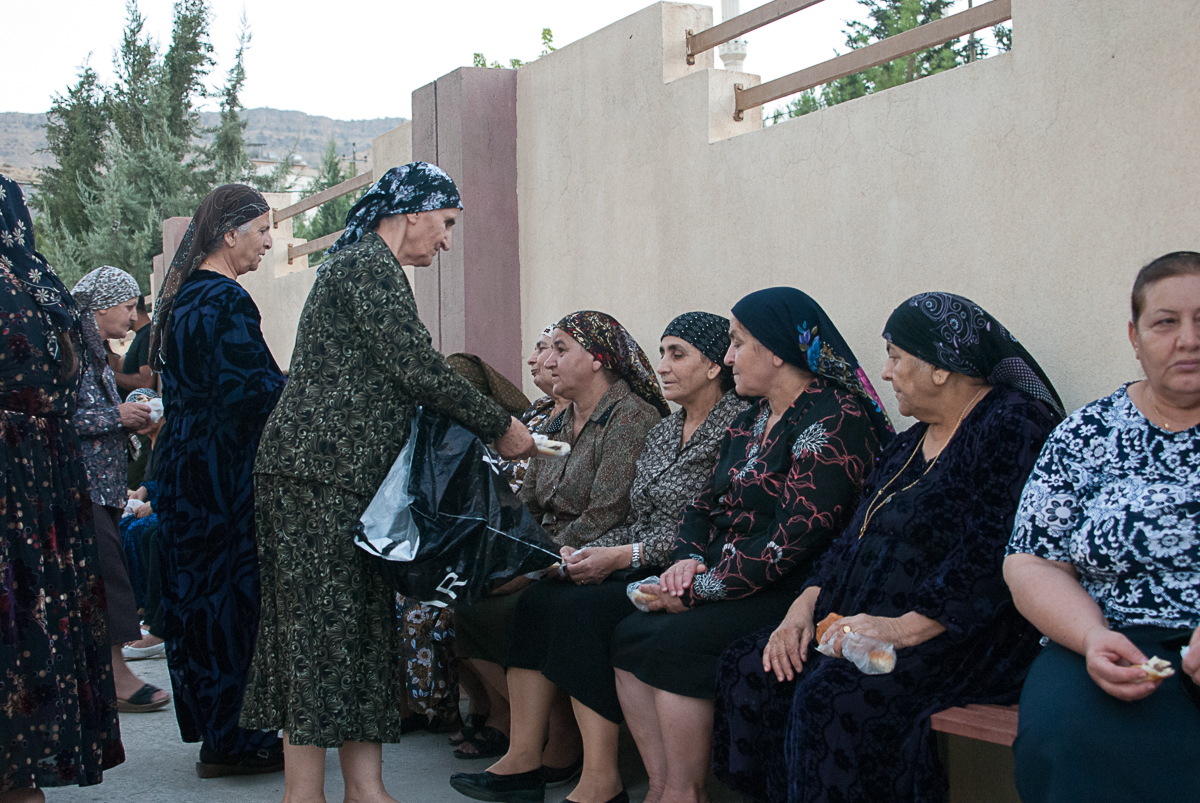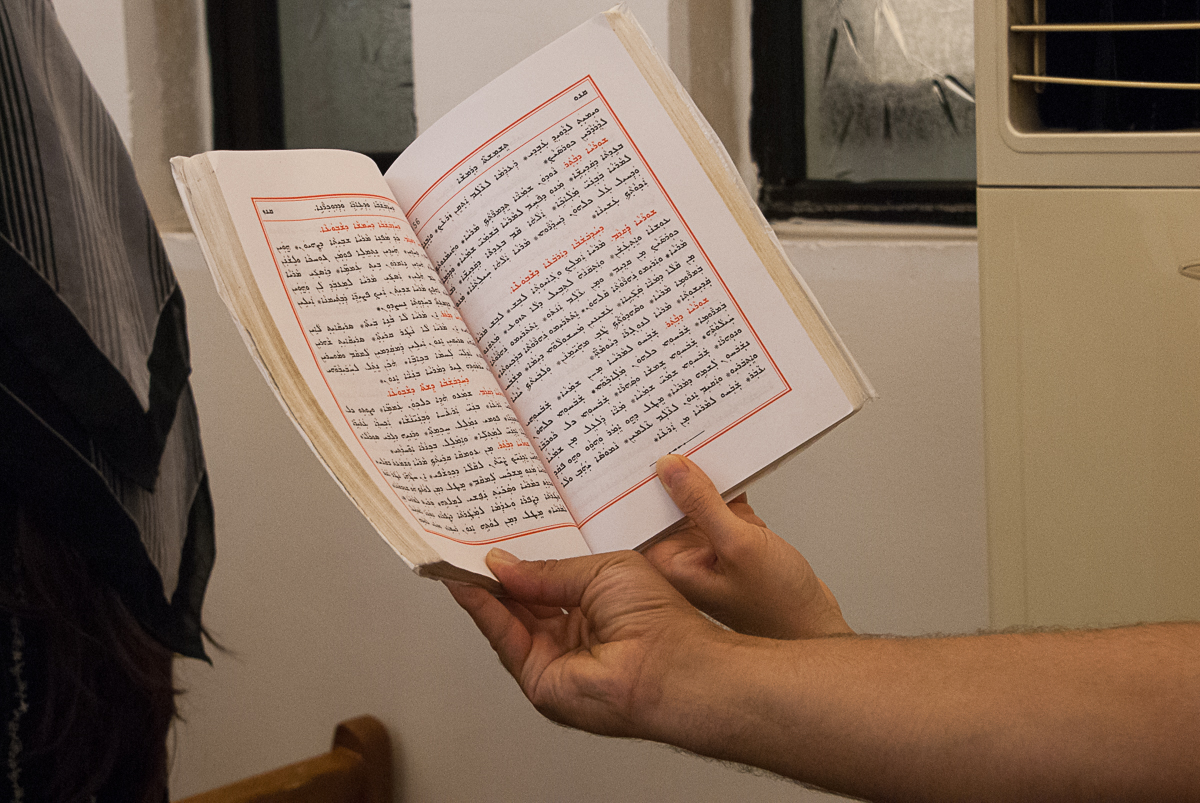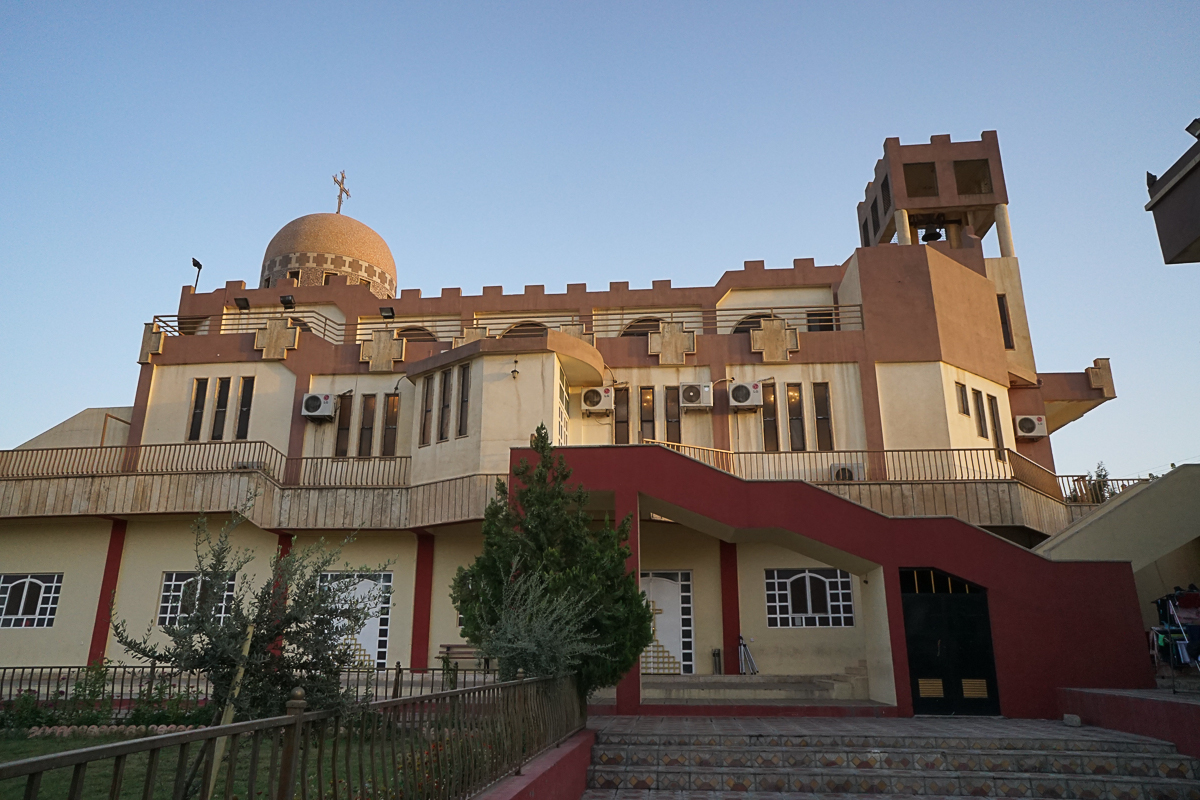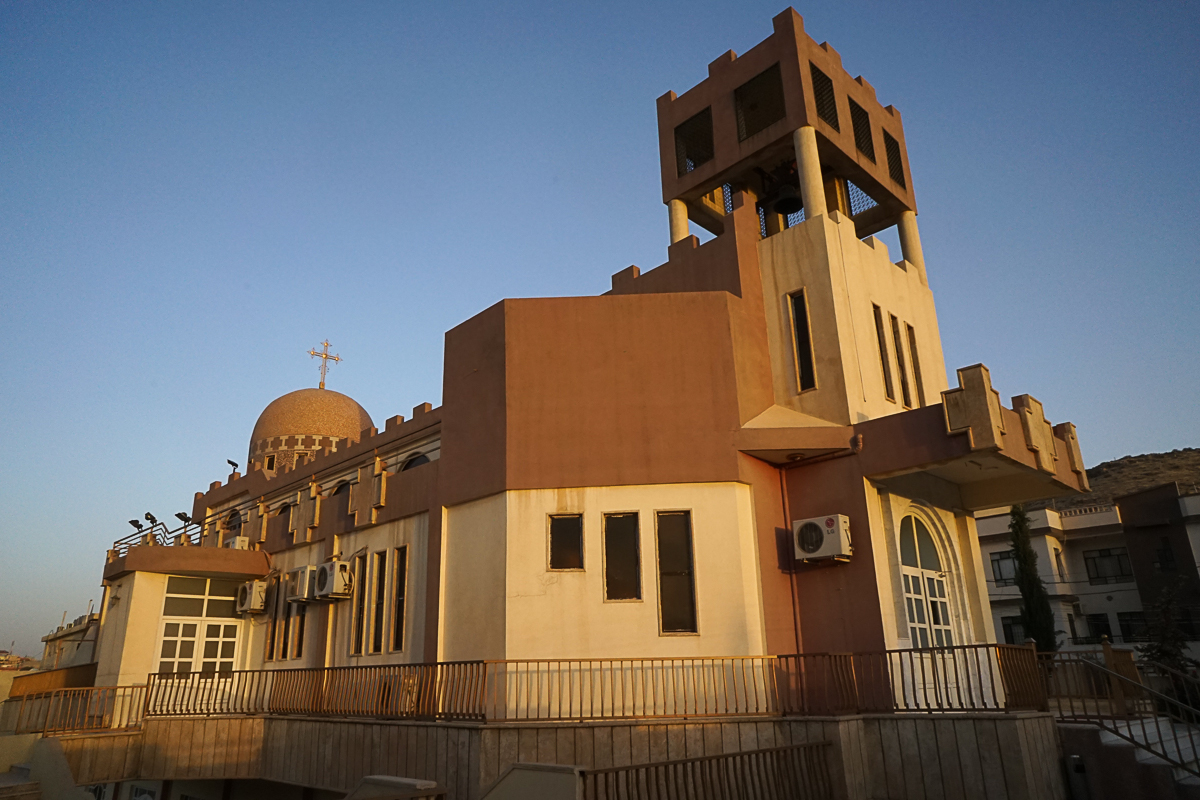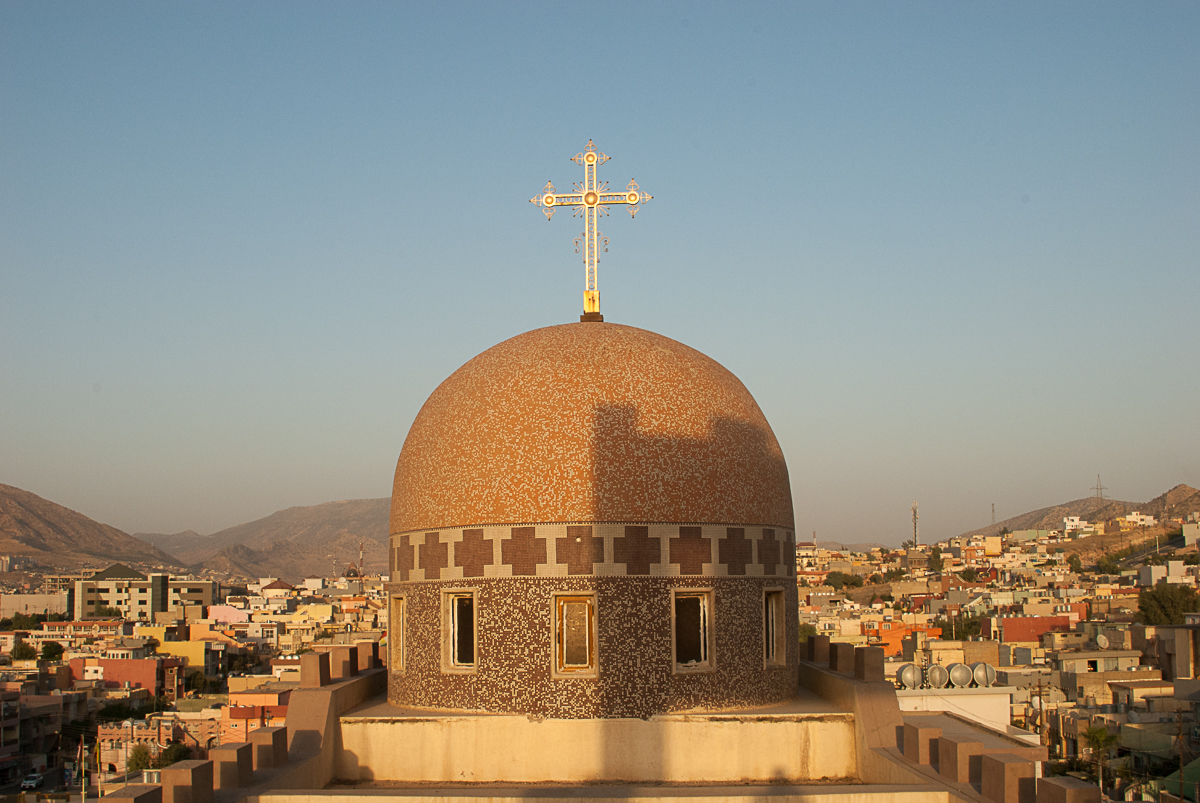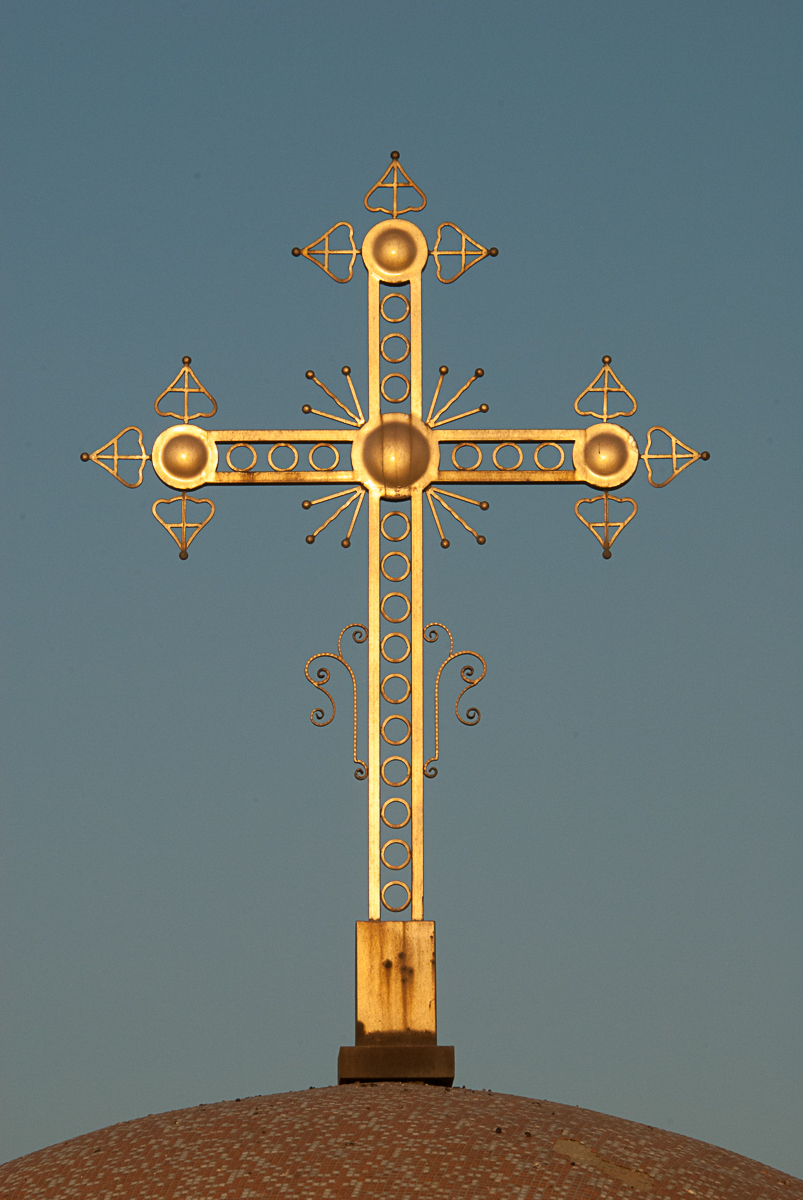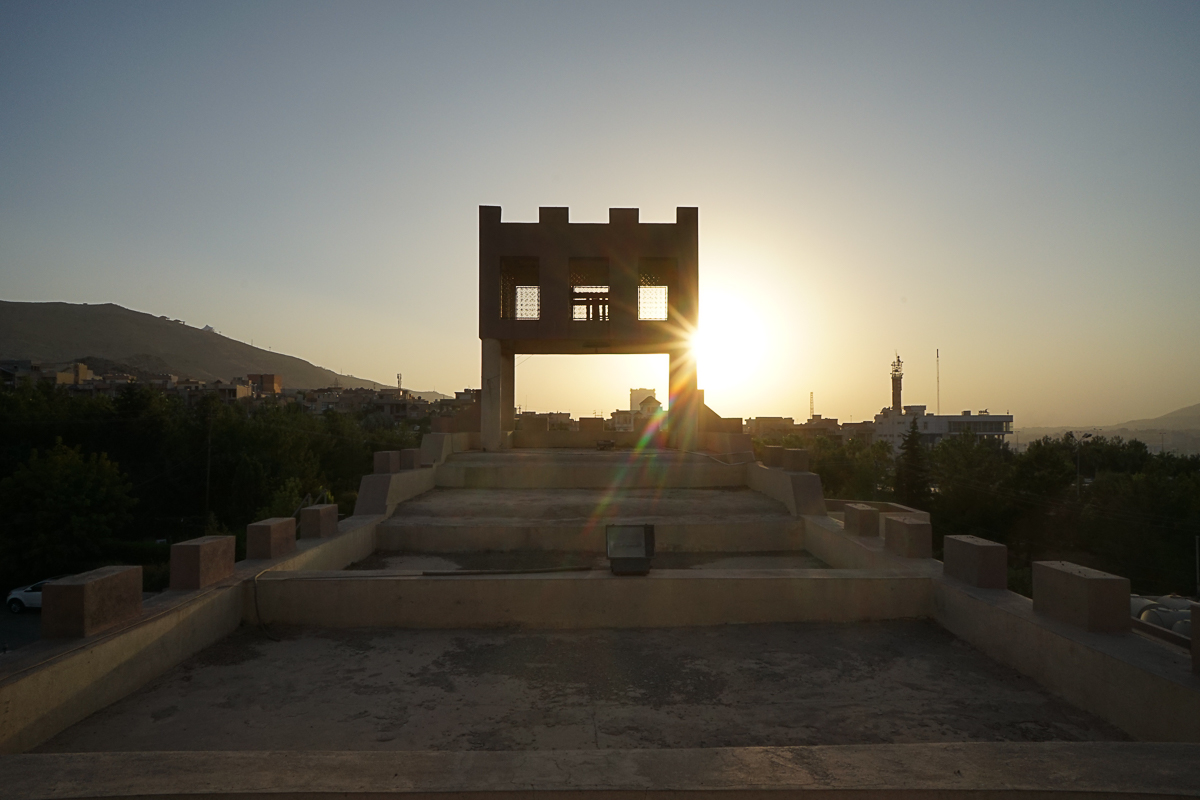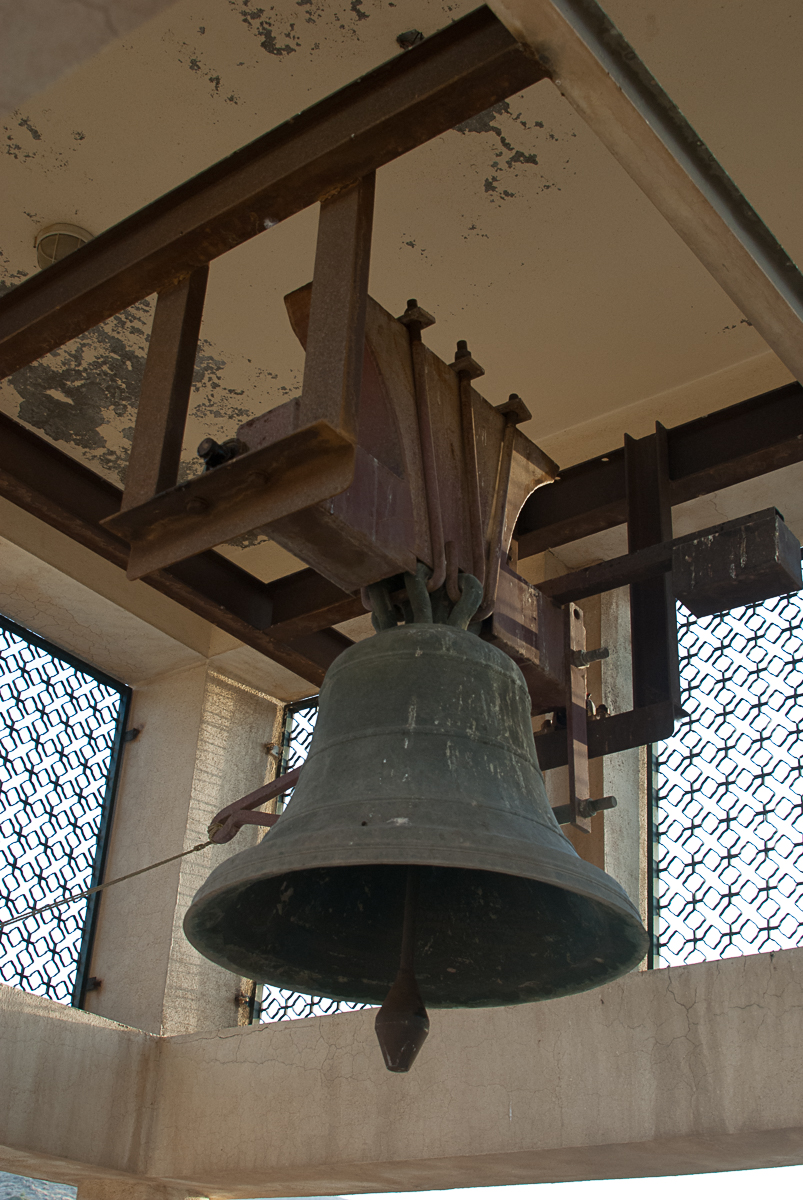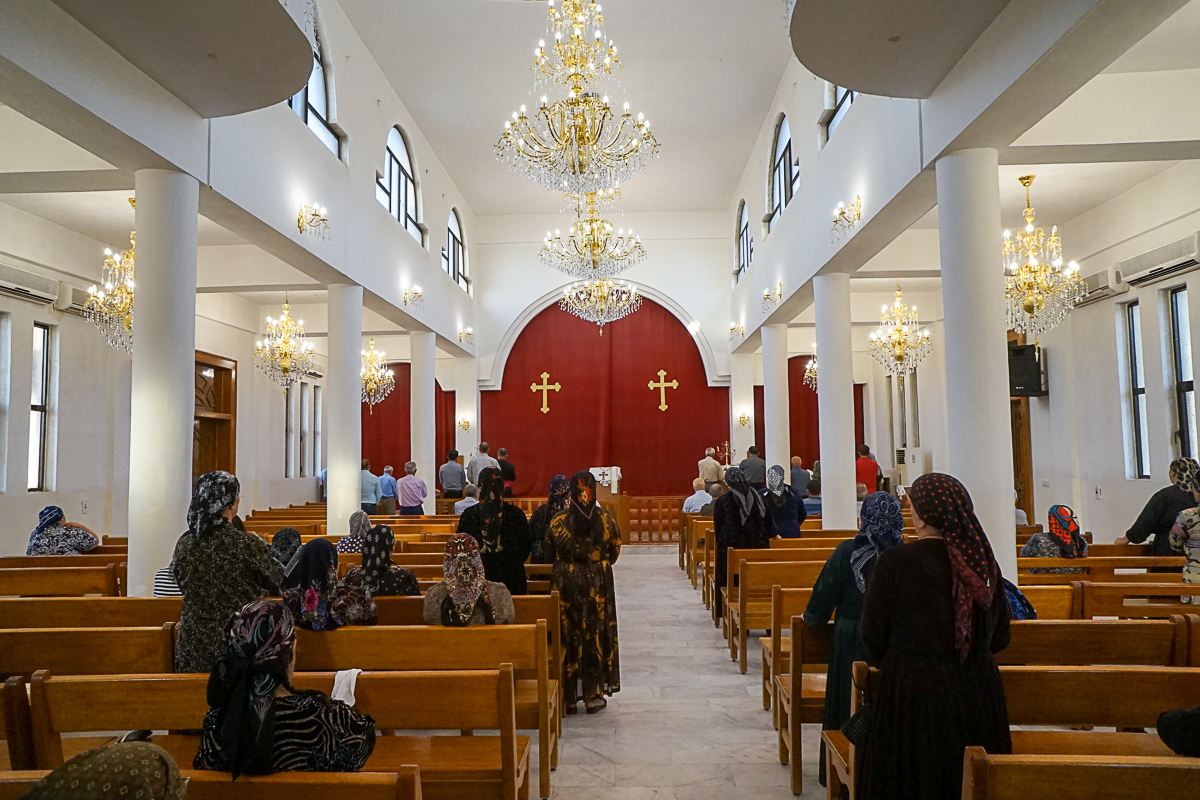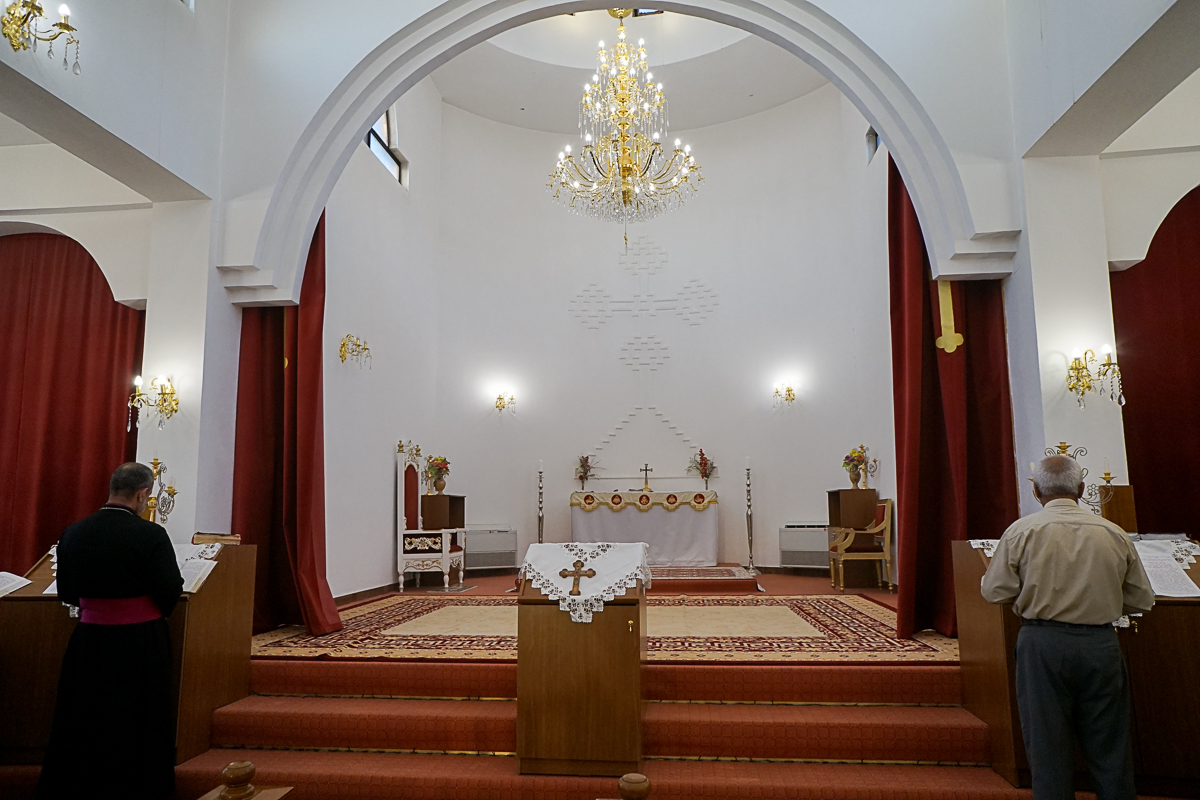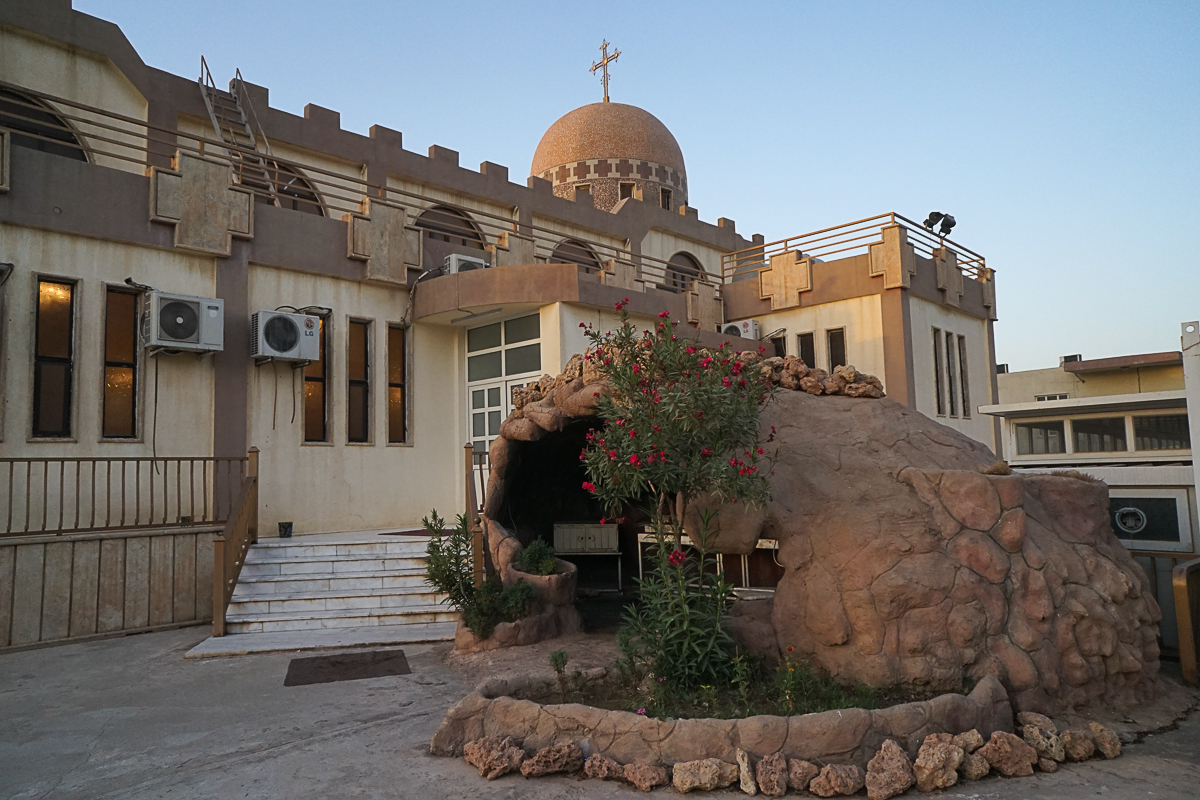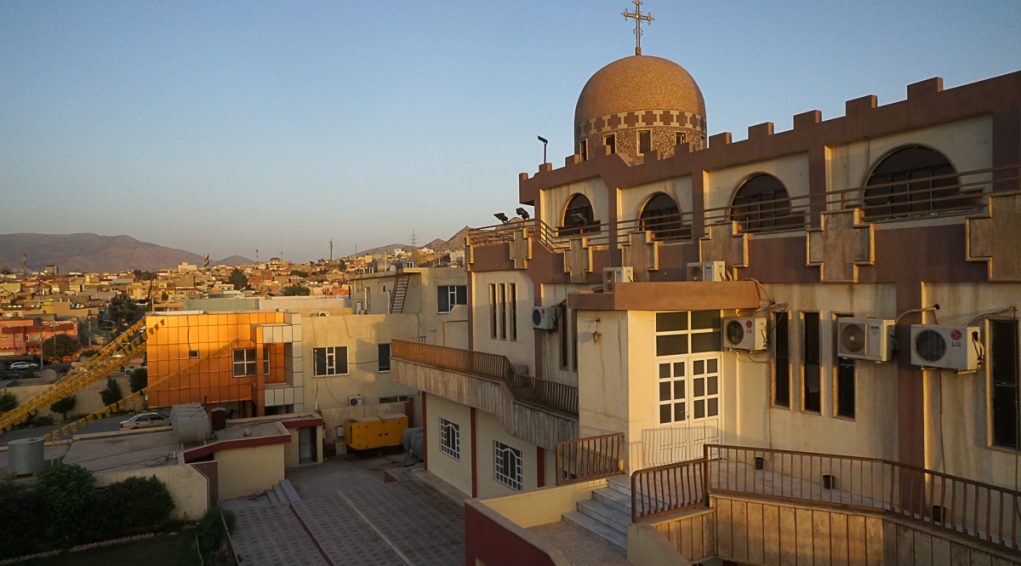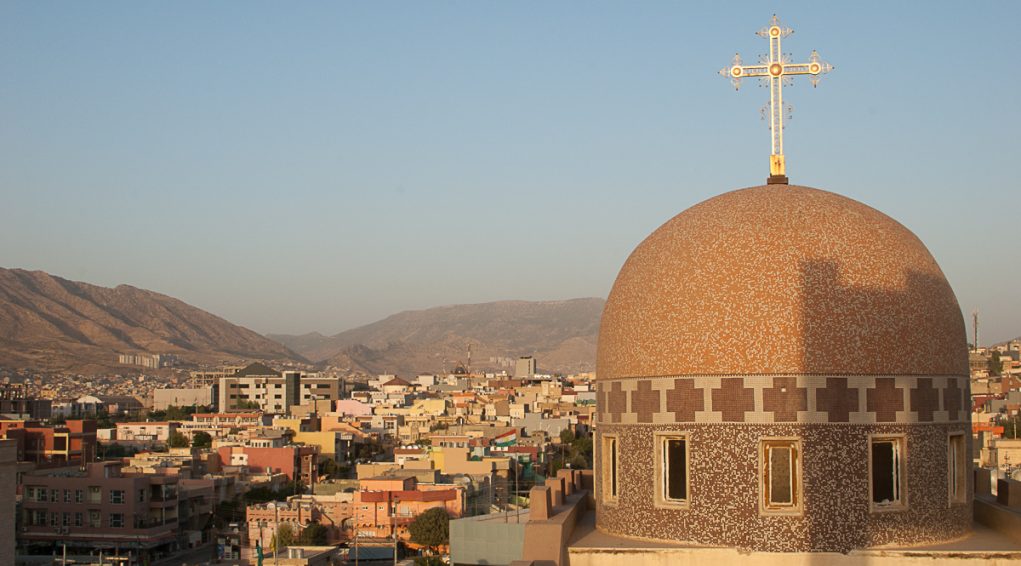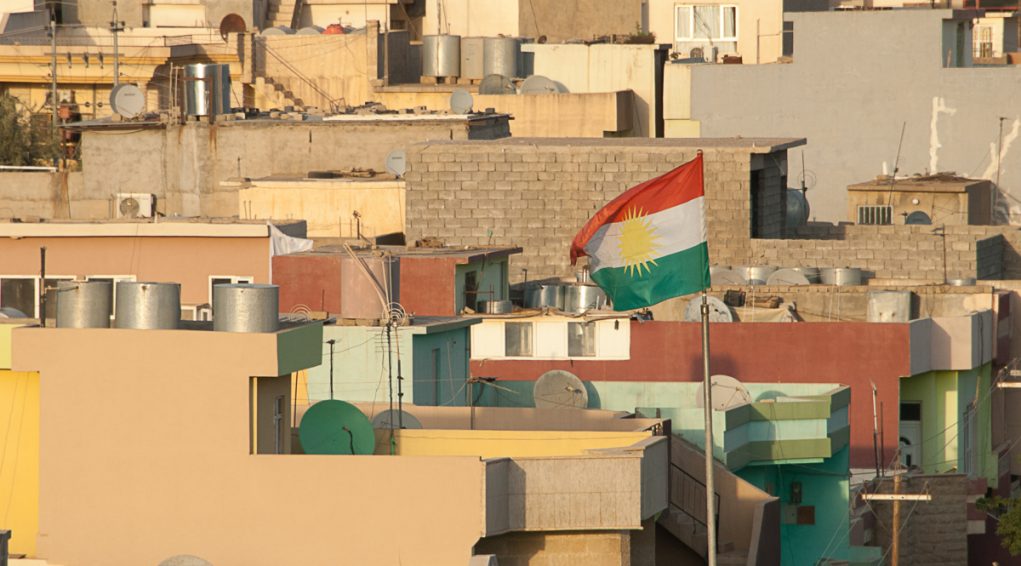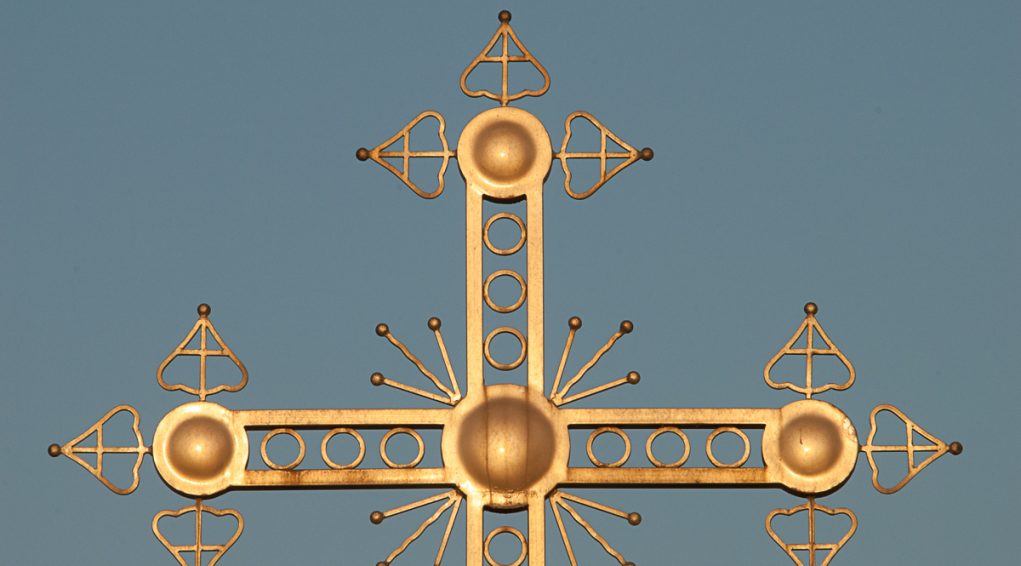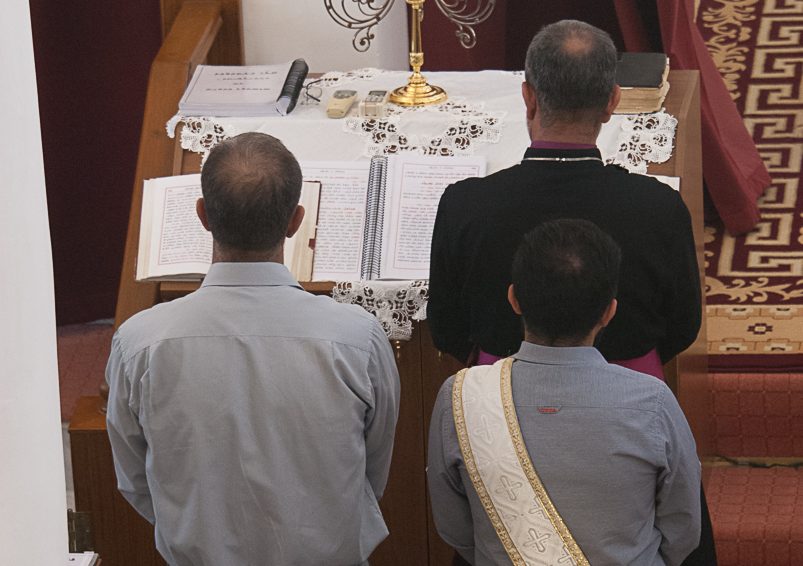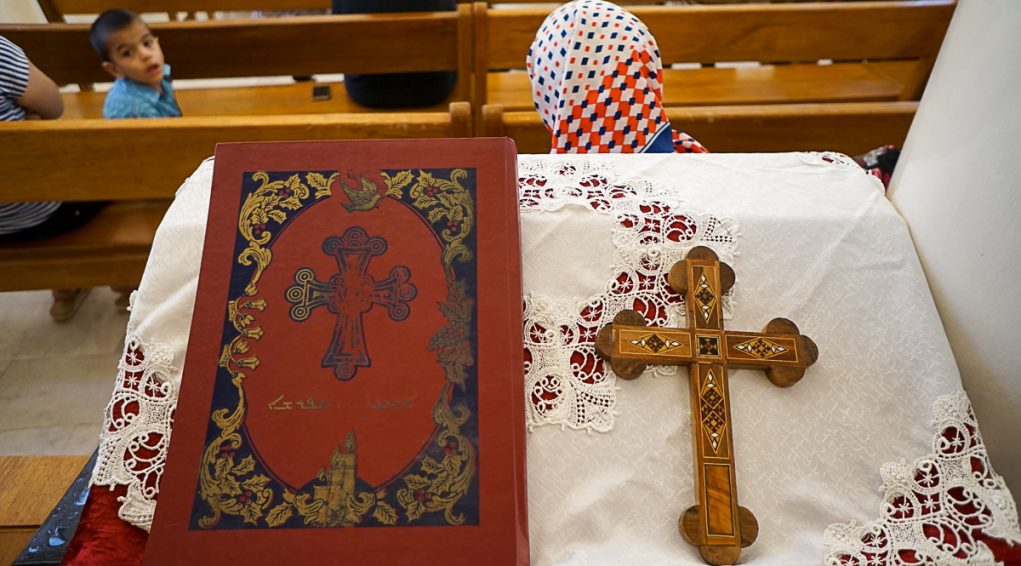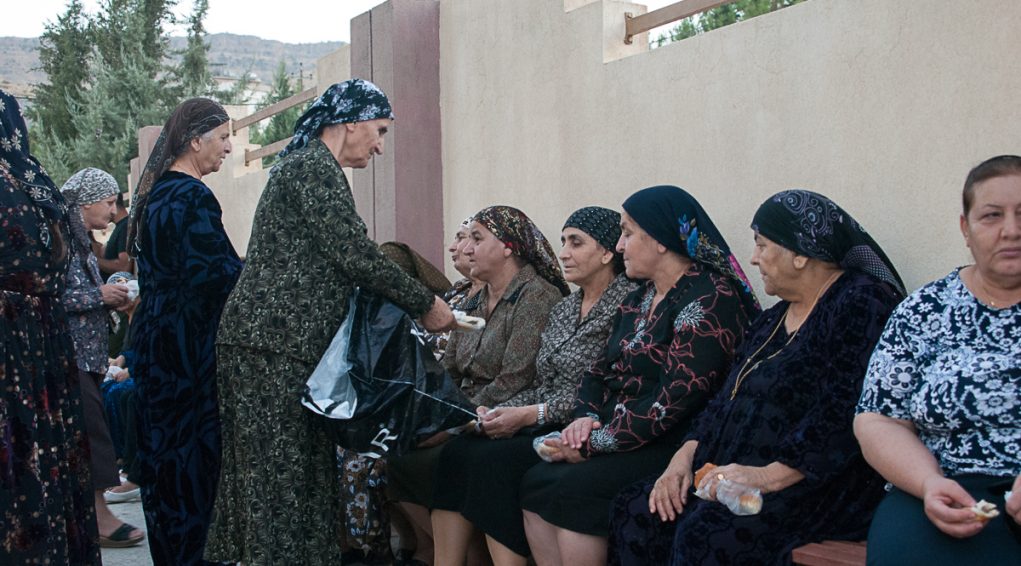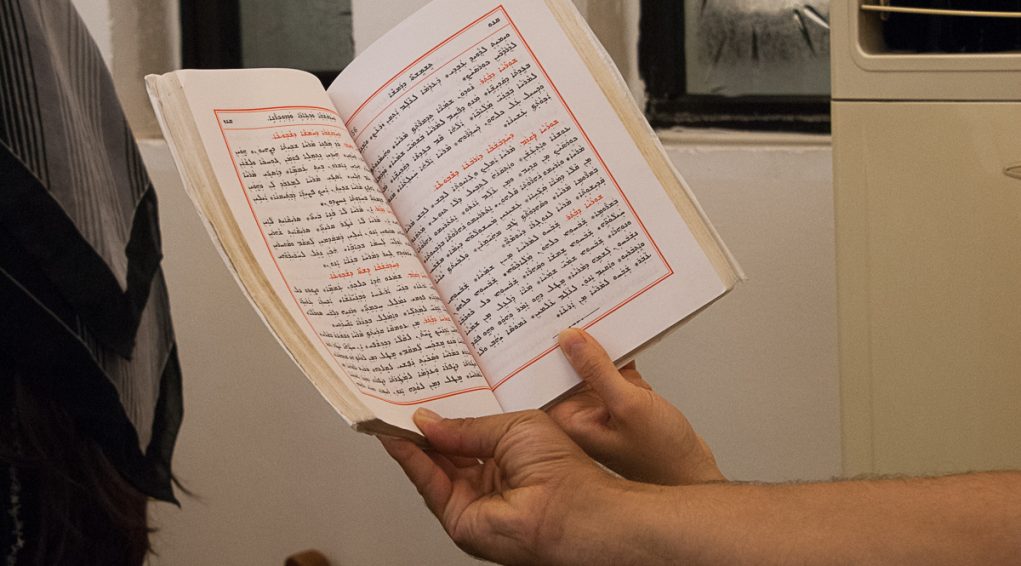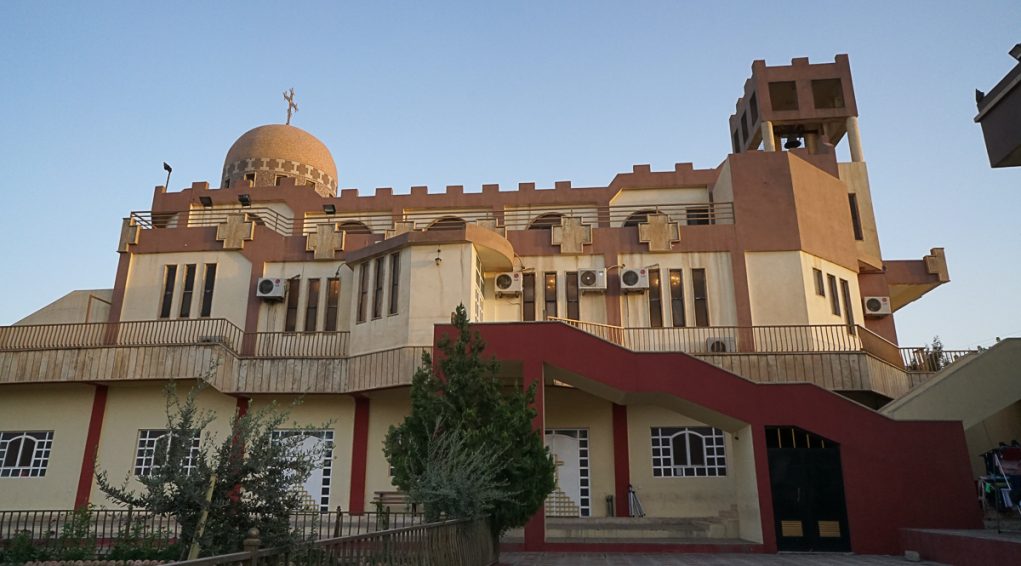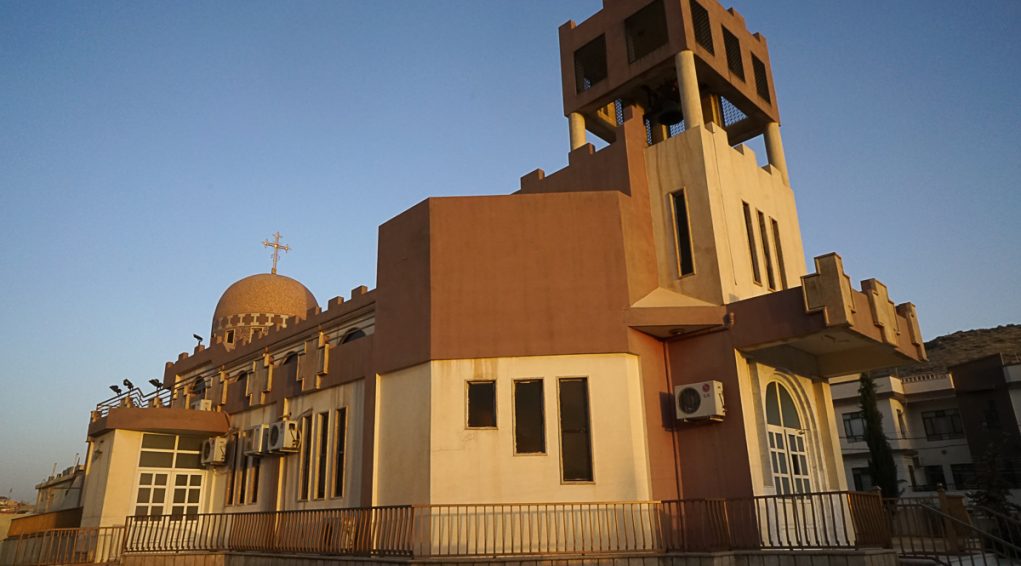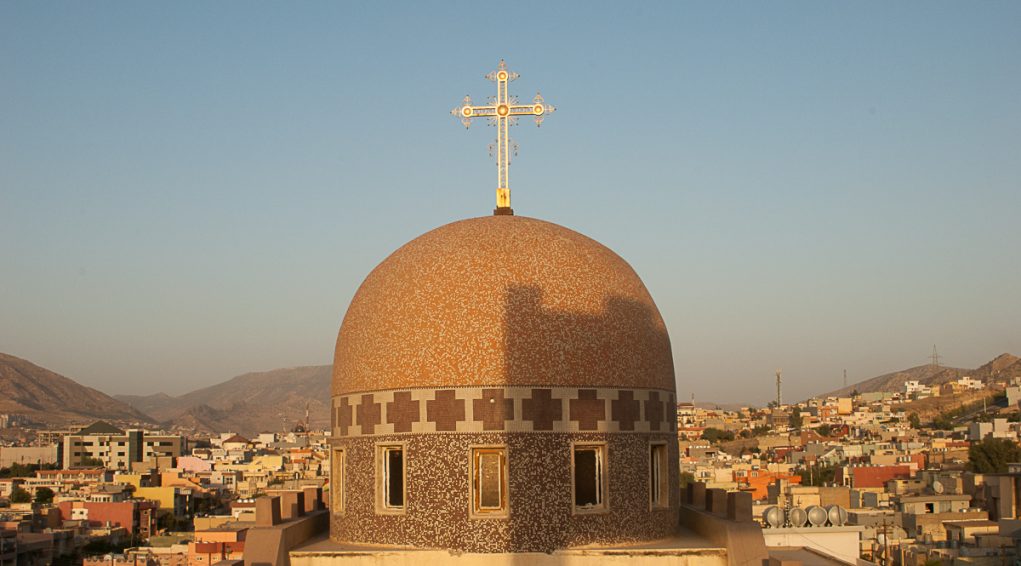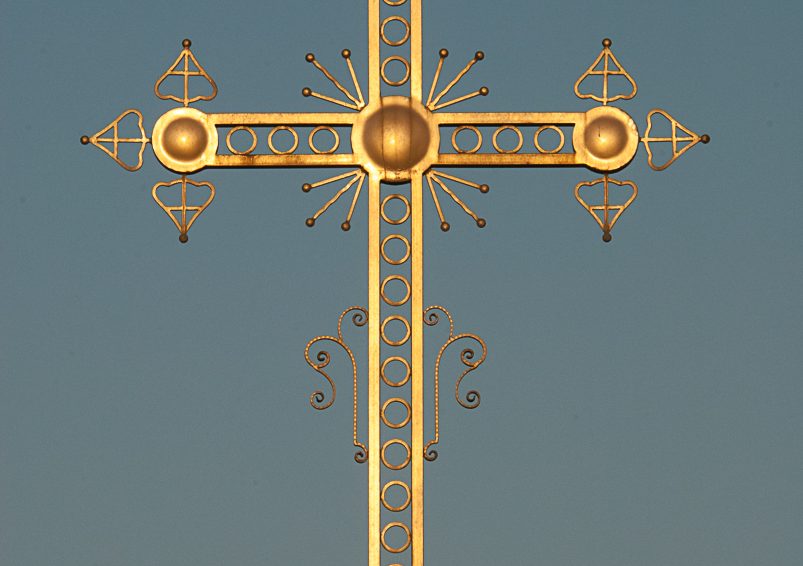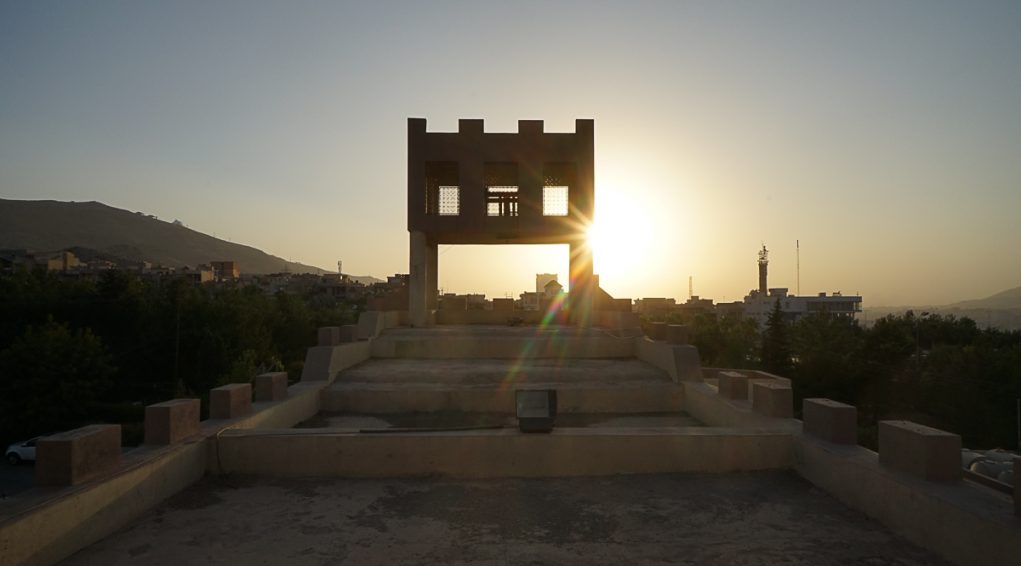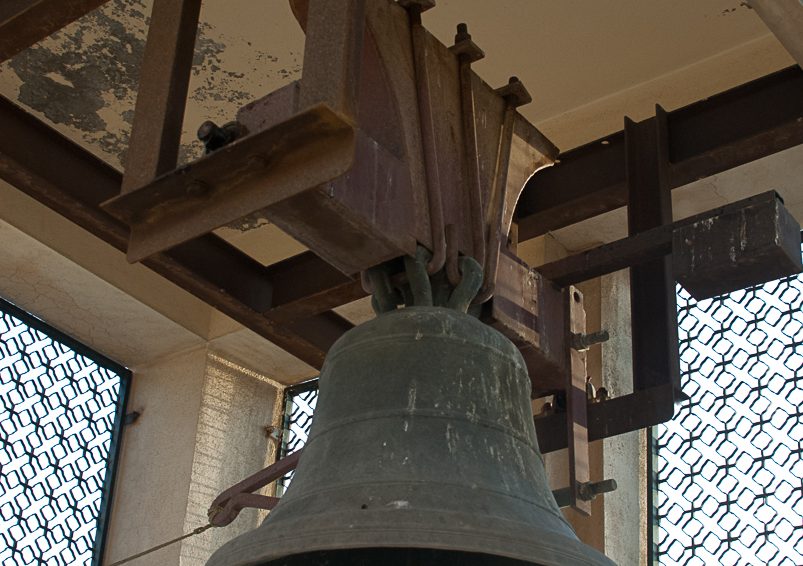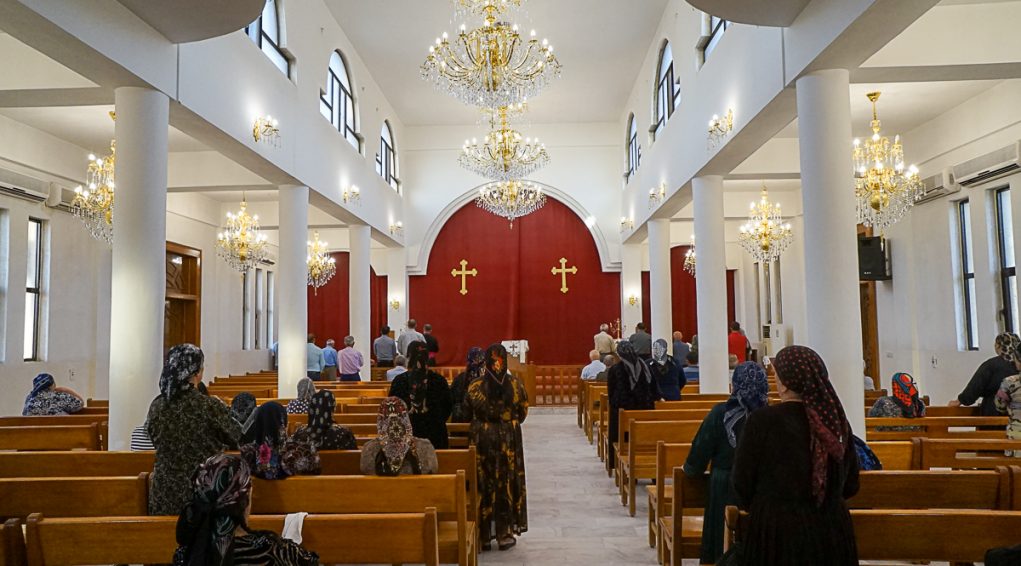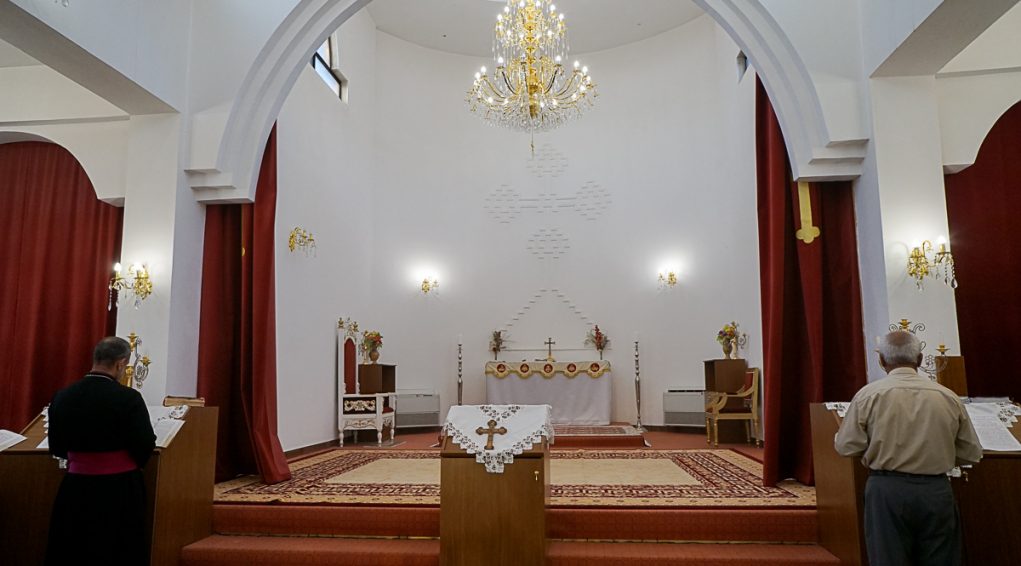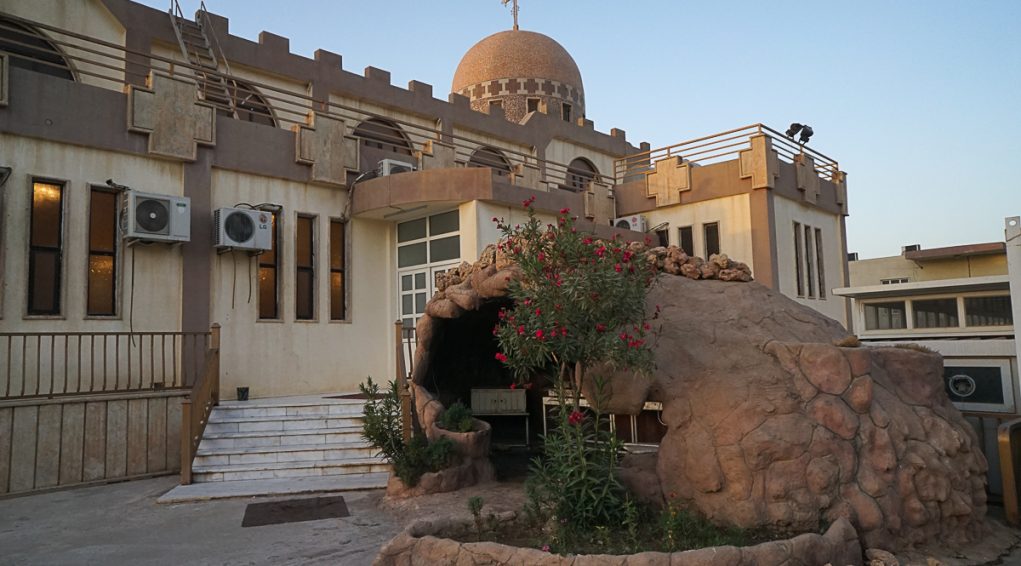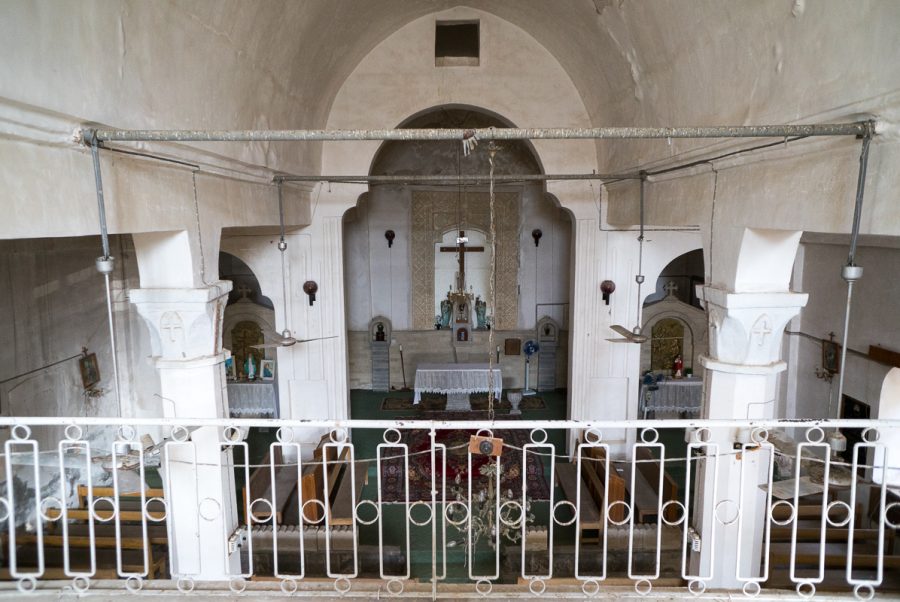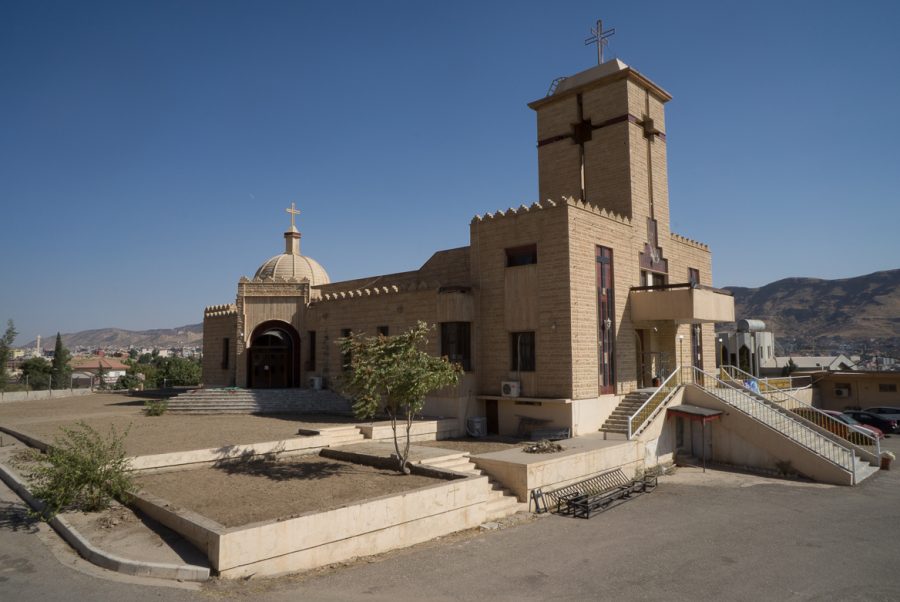The Assyrian Mar Narsai Church in Dohuk-Nohadra
The Mar Narsaï church in Dohuk-Nohadra is located at 36°50’43.0″N 43°00’21.8″E and 597 metres altitude, to the south of Dohuk-Nohadra.
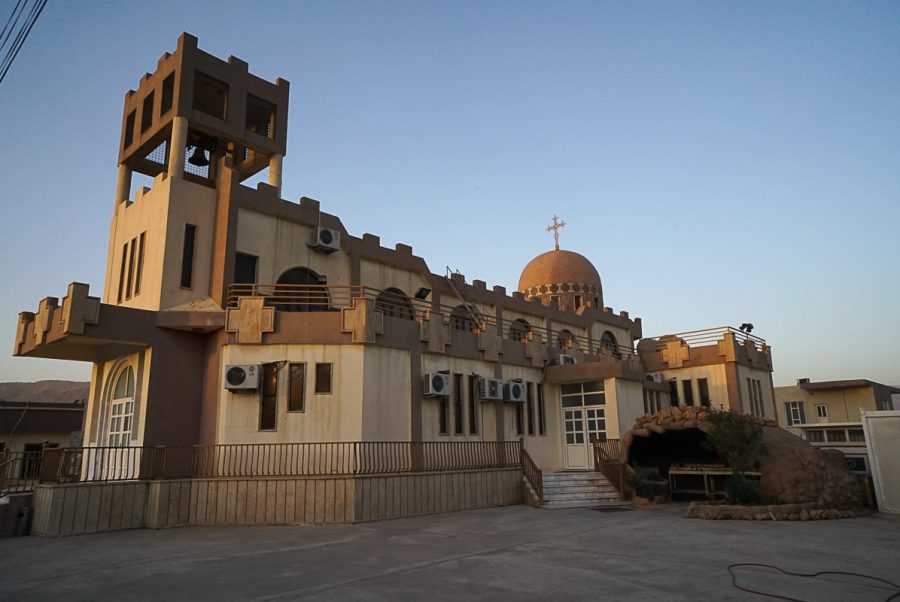
At the end of the 19th century and on the eve of the First World War, the population of the Assyrian nation was estimated at one million people in Iraq, Iran and Turkey. In 1957, there were 750,000 to 1 million Assyrians in Iraq. At the start of the 1970s, this figure fell to 300,000. In 2017, there were less than 40,000. This demographic collapse is the consequence of a series of historic disasters.
The Mar Nasai church was built in 2005. It is a modern building, made of reinforced concrete. To the east, above the sanctuary, the church is mounted with an attractive raised drum dome with rectangular windows, covered in small ceramic tiles, at the summit of which stands a golden metal clover-leaf cross. The inside of the triple nave building is very soberly adorned. The only ornament are the chandeliers.
Photo : The Assyrian Mar Narsai church in Dohuk-Nohadra. August 2017 © Pascal Maguesyan / MESOPOTAMIA
Location
The Mar Narsaï church in Dohuk-Nohadra is located at 36°50’43.0″N 43°00’21.8″E and 597 metres altitude, to the south of Dohuk-Nohadra, next to the Barzani park, 100 metres below the road which passes through the town from east to west, 46 km north of Alqosh, 80 km north of Mosul and 150 km north-west of Erbil, the capital of Iraqi Kurdistan.
The names of the Holy Apostolic Catholic Assyrian Church of the East
The Holy Apostolic Catholic Assyrian Church of the East is known by several names. Here we will simply mention the “Church of the East” in opposition to the Church of the West; “Church of Assyria” and “Church of Meopotamia” which identify its members with these ancient civilisations; “Church of Persia”, as it was under the eponymous Empire that the Eastern Christians structured their geopolitical space and that so many were martyred; and the “Nestorian Church” as it was established by consent with the Christology of the patriarch of Constantinople Nestorius deposed at the Council of Ephesus in 431.
The official denomination Holy Apostolic Catholic Assyrian Church of the East is the most complete. Founded and legitimised by the apostle Thomas, the church is proud of its roots in ancient times and places an emphasis on its missionary work.
Origins of the Holy Apostolic Catholic Assyrian Church of the East
According to the tradition, the origin of the Holy Apostolic Catholic Assyrian Church of the East go back to the apostles and disciples including Thomas, Addai (some assert that Addai is also the disciple Thaddeus, also known as Jude) and Mari. The tradition also recounts that Thomas“stopped in Seleucia-Ctesiphon during his journey to India.”[1]
The new religion would have been specifically preached to local Jewish communities. “We have no sources regarding the circles that were concerned with evangelization; however it seems sensible to think that the first ones to convert were taken among Jewish population, very important in those times throughout Mesopotamia, and even beyond the Tigris River, from the days they had been deported to Babylonia by Nebuchadnezzar. Most likely the greatest efforts to convert people were focused on these Jewish communities, as it already was the case in all cities of the Roman Empire.”[2]
It was really from the 4th century on that the Holy Apostolic Catholic Assyrian Church of the East started structuring itself in Seleucia-Ctesiphon and almost simultaneously the Persian King Shapur II ushered in an era of anti-Christian persecution, resulting in large numbers of martyrs who are still worshipped centuries later.
In the 5th century, the conflict between the Roman Empire and the Persian Empire, along with Christological disputes between schools of theology, widened the gap between the Churches of the West and the East. After having rejected the conclusions of the Council of Ephesus (431) and welcomed in the patriarch Nestorius, the Church of the East confirmed its break with Rome and Constantinople and asserted its autocephalous nature. This was the second act in the birth of the Church of the East, after it was founded by Saint Thomas.
_______
[1]In Histoire de l’Église de l’Orient, Raymond le Coz, published by Éditions du Cerf, 1995, p.21
Fragments of history: the Assyrians from the 16th to the 21st century
In the 16th century, the schism within the Holy Apostolic Catholic Assyrian Church of the East, engendered the Chaldean Church (in communion with Rome) and caused a major upheaval. The majority of Christians in the Apostolic Assyrian Church of the East progressively turned to the Chaldean Catholic Church, The consequences of this schism were such that the great Church of the East of the first centuries became “at the end of the Middle Ages, a mere Church-nation”, isolated in the mountainous border regions of the Persian (north-west Iran) and Ottoman (extreme south-east of Turkey and north of Iraq) Empires.[1]
Under Ottoman domination through the 19th century, Kurdish tribes pillaged Christian villages, killing and kidnapping the inhabitants. In 1843 – 1847 the massacres committed were truly horrendous: “The Kurdish Emir of Bohtan Béder-Khan butchered the Assyrians and Chaldeans in the province of Van. Over 10,000 men were massacred, thousands of women and young girls kidnapped and forced to covert to Islam, all the Assyrians’ and Chaldeans’ possessions and villages were burned to the ground.[2]”In 1894-1896 the nature of the massacres of the Christians (Armenians, Assyrians, Chaldeans and Syriacs) changed. These were organised at the highest levels of the empire by Sultan Abdul Hamid II, known as the Red Sultan, who sent out his hamidiyé to attack Christian localities. This genocide left the Christian communities almost wiped out of existence.
When the nationalist Young-Turk revolution overthrew the Sultan in 1908, Christians in the Empire were filled with a last gasp hope for a change in fortunes. This was illusory. As of 1909, the Adana massacres constituted the prelude to the systematic, planned destruction of the Christian communities, carried out under the cover of the First World War from 1915 – 1917. From the very start of the war, in the autumn of 1914, Turkish and Kurdish troops entered into Persia and massacred the Assyrian and Chaldean communities in the Ourmiah district. In April 1915, when the genocide of the Armenians began in the eastern provinces of the Ottoman Empire, 150,000 Assyrian survivors grouped together in the Hakkari mountains (extreme south-east of Turkey) from the vilayetof Van around the patriarchal seat of Kotchanes[3](since 1662), residence of the Catholicos Mar Schemoun “member of the family of the same name, guarantor of the traditions and nepotism exercised within it since 1450.[4]” The Hakkari Assyrians resisted their Turkish and Kurdish attackers ferociously, but were forced into exile in Persia. “They crossed the high mountains towards Salmas in Iran on 7 – 8 October 1915. The survivors, 50,000 out of 100,000 arrived exhausted. They were taken in by the Russian army and their compatriots (…) But the local population was against them and their compatriots living there were ruined.[5]” From 1915 to 1917, the massacres of the Armenians, Syriacs, Chaldeans and Assyrians continued and intensified, spreading to all the towns and villages in the Ottoman provinces of Van, Bitlis, Mamuretulaziz, Erzeroum, Diyabakir and Aleppo. These horrific massacres led to a mass exodus which killed even more people as they headed for the deserts of Syria and Mesopotamia. During the summer of 1918, abandoned by their Russian protectors “around eighty thousand Assyrians and Chaldeans, with their cattle and their belongings[6]”once again took to the road from Ourmiah, towards Hamadan in Persia, before finally arriving in Mesopotamia in Bakouba (50 km north-east of Baghdad). Half of the displaced population perished during this further ordeal.
In Mesopotamia under British rule, the Assyrians were used as combat troops, the Assyrian Levies,who helped to maintain order whilst hoping this would see them awarded political favours for the Assyrian Chaldean nation. “Rather than a State, the still-born treaty of Sèvres signed on 10 August 1920, signed between Turkey and associated allied powers, only afforded the Assyrian-Chaldeans guarantees and protection as part of a future autonomous Kurdistan. The treaty never came into force.[7]” The 6,500 Assyrians commanded by General Agha Petros could only count on themselves and attempted to take back Hakkari in October 1920, but this degenerated into a punitive and ultimately fruitless expedition. In 1923, the Lausanne treaty killed off the Assyrians’ and Armenians’ illusions of autonomous rule, simultaneously ruling out any chance of return. When the British mandate came to an end and Iraq became independent on 3 October 1932, the Iraqi authorities wanted to disperse the Assyrian Chaldeans. The Assyrians refused and entered into resistance. A thousand of them took up arms and travelled to Syria which was under French rule at this time, in July 1933, with a view to negotiating the collective, long-term settlement of their community. When they returned to Iraq at the beginning of August, via the village of Faysh Khabur to meet up with their families, the Assyrian fighters were shot down by King Faisal’s troops, but they managed to defeat the Iraqi forces. This affront caused Iraqi troops to take their revenge against the Assyrian-Chaldean villagers of Simele, close to Dohuk. The massacre began on 8 August 1933, with help from the Kurdish tribes. Three thousand men, women and children had been killed by 11th August. “The Arab officers and soldiers who committed these crimes were promoted and received a triumphant welcome in Mosul and Baghdad; their leader, the Kurdish Colonel Baker Sedqi, was made a General.”[8]
The rest of the 20th century was not much better for the Assyrian-Chaldeans. During the Second World War, new Assyrian combat units contributed to the British war effort against an Iraqi government supported by Nazi Germany. They obtained no diplomatic rewards. As of 1961, and up until 2003, the successive civil wars opposing Kurdish separatists and the Baghdad government had an appalling effect on the Assyrian-Chaldean Christian communities in the north of the country: killings, blackmail, destruction of heritage, forced population displacements, forced Arabisation, gas attacks etc. In 2003, end of the tyrannical regime of Saddam Hussein, marked the start of a chaotic period of Islamism and organised crime, during which criminal groups such as Al-Quaeda and ISIS persecuted Christian communities. Against all expectations, in the Kurdish mountains, the Assyrians and other Christians of Iraq benefited from a historic period of respite, thanks to the benevolence of the Kurdish regional government which implemented policies favouring the reinstallation of native-speaking Christian communities. The Church of the East could finally look to the future.
_______
[1]In “Du génocide à la diaspora : les assyro-chaldéens au XXesiècle”, Joseph Alichoran, Article published in the review Istina, 1994, N°4, October-December, p.4
[2]Eugène Griselle in “Qui s’en souviendra ? 1915 :le génocide assyro-chaldéo-syriaque.”, Joseph Yacoub, Les éditions du Cerf,, p.128
[3]In 1988, nothing remained of this patriarcate other than the patriarchal church Mar Shallita, built in 1689 and in poor condition. What remains in 2018 ? Source Joseph Alichoran.
[4]In “Du génocide à la diaspora : les assyro-chaldéen au XXesiècle”, Joseph Alichoran, Article published in the review Istina, 1994, N°4, October-December, p.5
[5]Eugène Griselle in “Qui s’en souviendra ? 1915 : le génocide assyro-chaldéo-syriaque.”, Joseph Yacoub, Les éditions du Cerf,, p.149
[6]In “Du génocide à la diaspora : les assyro-chaldéens au XXe siècle”, Joseph Alichoran, Article published in the review Istina, 1994, N°4, October-December, p.22
[7]In “Du génocide à la diaspora : les assyro-chaldéens au XXe siècle”, Joseph Alichoran, Article published in the review Istina, 1994, N°4, October-December, p.24
[8]In “Du génocide à la diaspora : les assyro-chaldéens au XXe siècle”, Joseph Alichoran, Article published in the review Istina, 1994, N°4, October-December, p.29
Assyrian demographics in Iraq
At the end of the 19th century and on the eve of the First World War, the Assyrian nation was estimated at one million people in Iraq, Iran and Turkey. In 1957, there were 750,000 to 1 million in Iraq. At the start of the 1970s, this figure fell to 300,000. In 2017, there were less than 40,000. This demographic collapse is the consequence of a series of historic disasters.
The main Assyrian populations in Iraq are found in Dohuk-Nohadra where there are 2,000 families. Around Dohuk-Nohadra, in the districts of Barwar, Simele, Zakho and Amadia, there are 1,500 families spread across 55 villages. In total, the province of Dohuk-Nohadra is home to around 20,000 Assyrians. [1]
Four major monasteries of the Holy Apostolic Catholic Assyrian Church of the East remain: Mar Audicho’ in Déré, Mar Qayouma in Kani Massi Douré, Mar Gewarguis in Kani Massi Iyed and Mar Mouché in Kani Massi Tchélèk.
_______
[1]Source: Khoury Philippos, archpriest of the Mar Narsaï church in Dohuk-Nohadra part of the Holy Apostolic Catholic Assyrian Church of the East.
Who was Mar Narsaï (Saint Narsai)?
Narsai was born at the beginning of the 5th century in Aïn Doulbé in the region of Ma`alta, in the governorate of Dohuk-Nohadra (today a district of Dohuk-Nohadra) whilst Mesopotamia was under Persian Sassanid control. At a time of intense Christological and theological debate, Narsai was a pupil at the school of Edessa (under Western, Roman influence). He followed teachings based on the doctrine of Antioch which was marginalised in 431 at the Council of Ephesus by those faithful to the doctrine of Alexandria. Narsai left Edessa for Nisibis, where he rejuvenated and headed up the Nisibis school of theology (towards 471), a sort of an eastern continuation of the school of Edessa but outside of the Roman sphere of influence. This led to him becoming a theologian of reference for the Church of the East (the so-called Nestorian church). Theologian and Syriac poet, Narsai also composed a number of exegetical texts in verse. Narsai died in around 502 -503.
History and description of the Assyrian Mar Narsaï (Saint Narsai) church in Dohuk-Nohadra
There are three Assyrian churches in Dohuk-Nohadra: Mart Mariam Adra, Mar Gorgis, Mar Narsaï.
The Mar Nasai church was built in 2005. It is a modern building built from reinforced concrete covered in an exterior two-tone brown-beige rendering, with a flat multi-level roof.
The main entrance door to the west is situated flush with the nave. The side doors are also positioned in the middle of the north and south facades. Above the western door is a square bell tower. To the east, above the sanctuary, the church is mounted with an attractive raised drum dome with rectangular windows, covered in small ceramic tiles, at the summit of which stands a golden metal clover-leaf cross.
The inside of the triple nave building is very soberly adorned. The only ornament are the chandeliers. The flat vault is supported by four pairs of freestanding, cylindrical pillars. Above these pillars, the upper walls are perforated with large semi-circular windows. The vault of the nave is higher than the side aisles.
A wooden choir screen separates the nave from the choir which is slightly raised. A large arch with a curtain opens onto the sanctuary, in which a high altar is supported by the wall of a semi-circular apse.
The baptistery and the sacristy are located either side of the high altar.
On the esplanade, against the south facade of the church, there is also a reproduction of the Lourdes cave.
Monument's gallery
Monuments
Nearby
Help us preserve the monuments' memory
Family pictures, videos, records, share your documents to make the site live!
I contribute